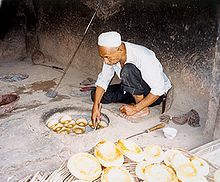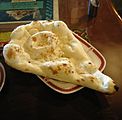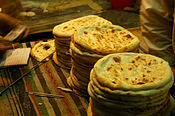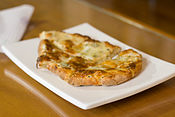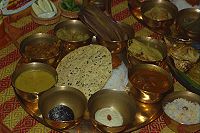- Naan
-
Naan 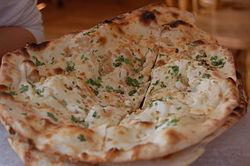
Naan with seasoningOrigin Place of origin Originally from Persia[1] Region or state Indian subcontinent, West, Central and South Europe Dish details Main ingredient(s) Wheat flour (e.g. atta, maida), water, yeast, cooking fat (e.g. butter, ghee), yogurt, milk (optional) Naan (Persian: نان, Urdu: نان, Punjabi: ਨਾਨ, Pashto: نان, Kurdish: nan) is a leavened, oven-baked flatbread.[1] It is typical of and popular in South and Central Asia,[2][3][4] in Iran, and in South Asian restaurants abroad. Influenced by the large influx of South Asian labour, naan has also become popular in Saudi Arabia and other Persian Gulf states.[5]
Originally, naan is a generic term for various flatbreads from different parts of the world.[6] In Turkic languages, such as Uzbek, Kazakh and Uyghur, the flatbreads are known as nan. The name stems from (New) Persian, a generic word for bread. In Burmese, flatbreads are known as nan bya (နံပြား; pronounced [nàɴbjá]).
Contents
Etymology
The earliest appearance of "naan" in English literature dates back to 1780, viz. in a travelogue of William Tooke.[7] The originally Persian word naan 'bread' (= Tajik non (нон)) is already attested in Middle-Persian / Pahlavi as n'n 'bread, food'. The form itself is either of Iranian or even Indo-Iranian origin; cognate forms include Parthian ngn, Balochi nagan, Sogdian nγn-, Pashto nəγan - "bread".[8] The form naan has a widespread distribution, having been borrowed in a range of languages spoken in central Asia, and in the aftermath of Muslim conquests, also in South Asia, i.e. present-day India, Pakistan, Bangladesh, Afghanistan and the surrounding regions. In these countries and regions, the generic designation "naan" refers to a kind of (in most cases) flatbread, baked according to locally adapted recipes.
Description
The most familiar and readily available varieties of "naan" in Britain (and other Western countries) are the South Asian varieties. In Iran, from which the word ultimately originated,[9] nān (نان) does not carry any special significance, as it is merely the everyday word for (any kind of) bread. On the other hand, naan in South Asia usually refers to a specific kind of thick flatbread (another well-known kind of flatbread is chapati). Generally, it resembles pita and, like pita bread, is usually leavened with yeast; unleavened dough (similar to that used for roti) is also used. Naan is cooked in a tandoor, or clay oven, from which tandoori cooking takes its name. This distinguishes it from roti, which is usually cooked on a flat or slightly concave iron griddle called a tava. Modern recipes sometimes substitute baking powder for the yeast. Milk or yoghurt may also be used to give greater volume and thickness to the naan. Typically, it will be served hot and brushed with ghee or butter. It can be used to scoop other foods, or served stuffed with a filling: for example, keema naan is stuffed with a minced meat mixture (usually lamb or mutton or goat meat); Another variation is peshwari or peshawari naan. Peshawari naan and Kashmiri naan are filled with a mixture of nuts and raisins; in Pakistan, the most famous naan variety is the Roghani naan which is sprinkled with sesame seeds; Kulcha is another type of Naan. Amritsari Naan also called as Amritsari Kulcha is stuffed with mashed potatoes, onion (optional) and lots of spices. Possible seasonings in the naan dough include cumin and nigella seeds. The Pakistani dish of balti, popular in Birmingham, England, is usually eaten with a naan, and this has given rise to the huge karack or table naan, easy to share amongst large groups.[10]
A typical naan recipe involves mixing white flour with salt, a yeast culture, and enough yogurt to make a smooth, elastic dough.[11] The dough is kneaded for a few minutes, then set aside to rise for a few hours. Once risen, the dough is divided into balls (about 100 grams or 3.5 oz each), which are flattened and cooked. In Pakistani cuisine, naans are typically graced with fragrant essences, such as rose, khus or (vetiver), with butter or ghee melted on them. Nigella seeds are commonly added to naan as cooked in Indian restaurants throughout the UK.
Raisins and spices can be added to the bread to add to the flavour. Naan can also be covered with various toppings of meat, vegetables, and/or cheese. This version is sometimes prepared as fast food. It can also be dipped into such soups as dal, and goes well with sabzis (also known as shaakh).
Naan bya in Burma is a popular breakfast choice, usually served with tea or coffee. It is round, soft, and blistered, often buttered, or with pè byouk (boiled peas) on top, or dipped in hseiksoup (mutton soup).
See also
- Tandyr nan
- Bazlama
- Bhatoora
- Chapati, another type of flatbread, also found in India
- Kulcha
- Luchi
- Naan burger
- Paratha
- Puri
- Roti
- Roti canai
Gallery
-
A cheese naan
References
- ^ a b Bernard Clayton's New Complete Book of Breads by Bernard Clayton, Donnie Cameron
- ^ Qmin by Anil Ashokan, Greg Elms
- ^ The Science of Cooking, Peter Barham, Springer: 2001. ISBN 978-3-540-67466-5. p. 118.
- ^ The Bread Lover's Bread Machine Cookbook by Beth Hensperger
- ^ Saudigazette.com
- ^ Crust & Crumb by Peter Reinhart
- ^ Russia, or a Compleat Historical Account of all the Nations which compose that Empire, London, p. 168: "The most common dishes are onoschi, or vermicelli; plav, or boiled rice; nan, pancakes, and the meats which the law permits." (referring to the eating habits of the Central Turks). Other attestations in English can be found in the Oxford English Dictionary, s.v. naan.
- ^ See for instance Manfred Mayrhofer, Etymologisches Wörterbuch des Altindoarischen, Heidelberg 1996, vol. 2, p. 6, with further references. An Indo-European origin for this typical cultural term is highly unlikely.
- ^ Merriam-webster.com
- ^ Birmingham, the latest hot destination for foodies
- ^ Recipe (video clip)
External links
Pakistani dishes by cuisine and region Balochi 
Kashmiri Muhajir Aloo tikki · Dahi chutney · Gil e firdaus · Hyderabadi biryani · Haleem · Masala chai · Nargisi Kofta · Nihari · Paan · SheermalPashtun Afghan bread · Bolani · Chapli kabab · Gosh Feel · Kabuli pulao · Kadchgall · Kadu bouranee · Kahwah · Mantu · Peshwari NaanPunjabi LahoriChargha · Golgappa · Halwa poori · Lahori fried fish · Gosht karahi · Murgh cholay · Paya · Kata-katElsewhereAloo gobi · Aloo paratha · Baingan ka bartha · Bhala · Bhatoora · Chana masala · Chapati · Chicken tikka · Chole bhature · Gajar ka Halwa · Lassi · Makki di roti · Panjiri · Papadum · Paratha · Punjabi pulao · Puri · Sarson da saag · Sohan halwa · Sugarcane juice · Tandoor bread · Tandoori chicken · TikkaSindhi Miscellaneous Pakistani diaspora  Indian breads
Indian breadsBaati • Bhakri • Bhatoora • Chapati • Davanagere Benne Dosa • Dosa • Idli • Jolada rotti • Kerala porotta • Khakhra • Kulcha • Luchi • Makki di roti • Manda Pitha • Naan • Neer dosa • Papadum • Paratha • Parotta • Pathiri • Pesarattu • Pitha • Puri (food) • Puttu • Rava dosa • Roti • Rumali Roti • Sheermal • Thalipeeth • Uttapam
Pakistani breads Bhatoora • Chapati • Hoyha • Kaak • Lavash • Naan • Papadum • Paratha • Phitti • Puri (food) • Roti • Rumali Roti • Sheermal • Taftan (bread)
Flatbreads Asia Barbari bread • Bazlama • Bhakri • Bhatoora • Bindaetteok • Bing • Bolani • Chapati • Dosa • Kulcha • Roast paan • Gözleme • Green onion pancake • Khanom buang • Laobing • Luchi • Malooga • Markook • Matzo • Naan • Papadum • Paratha • Pesarattu • Pita • Puri • Roti • Roti canai • Sanchuisanda • Sangak • Tandyr nan • Taboon bread • Yufka
Europe Crêpe • Crisp bread • Farl • Flammkuchen • Flatbrød • Flatkaka • Focaccia • Hoggan • Lavash • Lefse • Opłatek • Pancake • Pane carasau • Piadina • Pita • Podpłomyk • Rieska • Sacramental bread • Tunnbröd
Africa Aish Mehahra • Harsha • Injera • Lahoh • Mandezi • Ngome
Americas Arepa • Bammy • Casabe • Tortilla • Tortilla de Rescoldo
Bread Types Ingredients Equipment Processes Autolysis • Chorleywood bread process • Leavening • Maillard reaction • Proofing • Kneading • Baking • SteamingUses Other Breadmaking • Baker percentageCategories:- South Asian breads
- Central Asian cuisine
- Iranian cuisine
- Yeast breads
- Flatbreads
Wikimedia Foundation. 2010.

